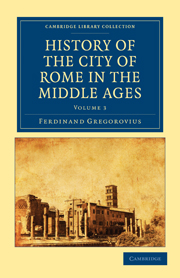CHAPTER I
Published online by Cambridge University Press: 05 July 2011
Summary
If in the ninth century the history of the city is lost in the history of her Popes and Emperors, during the tenth the Romans themselves come prominently into notice. The mediaeval Senate or nobility of the City begins with the fall of the Carolingian Empire and the Papal authority to make itself felt in history as an independent power.
Benedict IV., Pope, 900–903
Lewis of Provence, Emperor, 901
While two princes contended for the possession of Italy in the north, Rome remained filled with the noise of party warfare. No Imperial arm was any longer raised to repress the strife, and the Popes only mounted S. Peter's Chair to be hurriedly swept aside. The Roman, Benedict the Fourth, son of Mammolus, obtained the tiara in May or June 900. His brief reign remains marked solely by the coronation of Lewis of Provence, who had come at the summons of the Italians. The son of Boso received the crown in Rome, at the beginning of February 901, and some of the diplomas which he promulgated show that he actually exercised Imperial power in the city. A Roman placitum, of February 4th, 901, has been preserved, in which the leading nobles are enumerated as his judges. These are, Stefanus, Theophylactus, Gregorius, Gratianus, Adrianus, Theodoras, Leo, Crescentius, Benedictus, Johannes and Anastasius.
- Type
- Chapter
- Information
- History of the City of Rome in the Middle Ages , pp. 241 - 281Publisher: Cambridge University PressPrint publication year: 2010First published in: 1895

